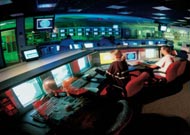Article from: www.thenewspaper.com/news/25/2537.asp
9/16/2008
Photo Ticket Cameras to Track Drivers Nationwide
Vendors plan to add spy technology to existing red light camera and speed camera installations.
 Private companies in the US are hoping to use red light cameras and speed cameras as the basis for a nationwide surveillance network similar to one that will be active next year in the UK. Redflex and American Traffic Solutions (ATS), the top two photo enforcement providers in the US, are quietly shopping new motorist tracking options to prospective state and local government clients. Redflex explained the company's latest developments in an August 7 meeting with Homestead, Florida officials.
Private companies in the US are hoping to use red light cameras and speed cameras as the basis for a nationwide surveillance network similar to one that will be active next year in the UK. Redflex and American Traffic Solutions (ATS), the top two photo enforcement providers in the US, are quietly shopping new motorist tracking options to prospective state and local government clients. Redflex explained the company's latest developments in an August 7 meeting with Homestead, Florida officials.
"We are moving into areas such as homeland security on a national level and on a local level," Redflex regional director Cherif Elsadek said. "Optical character recognition is our next roll out which will be coming out in a few months -- probably about five months or so."
The technology would be integrated with the Australian company's existing red light camera and speed camera systems. It allows officials to keep full video records of passing motorists and their passengers, limited only by available hard drive space and the types of cameras installed. To gain public acceptance, the surveillance program is being initially sold as an aid for police looking to solve Amber Alert cases and locate stolen cars.
"Imagine if you had 1500 or 2000 cameras out there that could look out for the partial plate or full plate number across the 21 states where we do business today," Elsadek said. "This is the next step for our technology."
ATS likewise is promoting motorist tracking technologies. In a recent proposal to operate 200 speed cameras for the Arizona state police, the company explained that its ticketing cameras could be integrated into a national vehicle tracking database. This would allow a police officer to simply enter a license plate number into a laptop computer and receive an email as soon as a speed camera anywhere in the state recognized that plate.
Such programs would be fully consistent with existing law on searches and seizures. In the 2003 case Washington v. William Bradley Jackson, the Washington State Supreme Court ruled that police could not use a physical GPS tracking device to monitor a suspect's movements without first obtaining a warrant. No warrant would be needed or restrictions applied to license plate tracking systems which do not require any physical contact. Instead, individual police officers could monitor the movements of suspected criminals or even their wives and neighbors at any time.
In the past, police databases have been used to intimidate innocent motorists. An Edmonton, Canada police sergeant, for example, found himself outraged after he read columnist Kerry Diotte criticize his city's photo radar operation in the Edmonton Sun newspaper. The sergeant looked up Diotte's personal information, and, without the assistance of electronic scanners, ordered his subordinates to "be on the lookout" for Diotte's BMW. Eventually a team of officers followed Diotte to a local bar where they hoped to trap the journalist and accuse him of driving under the influence of alcohol. Diotte took a cab home and the officers' plan was exposed after tapes of radio traffic were leaked to the press. Police later cleared themselves of any serious wrong-doing following an extensive investigation.
In the UK, officials are planning to dramatically expand the use of average speed cameras that track cars over distances as great as six miles. Records on all vehicle movements taken from a nationwide network of cameras will be stored for five years in a central government Automated Number Plate Recognition (ANPR) server, allowing police to keep tabs on criminals and political opponents. Work on the data center in north London began in 2005 and officials expect real-time, nationwide tracking capability to be available by January.
 Private companies in the US are hoping to use red light cameras and speed cameras as the basis for a nationwide surveillance network similar to one that will be active next year in the UK. Redflex and American Traffic Solutions (ATS), the top two photo enforcement providers in the US, are quietly shopping new motorist tracking options to prospective state and local government clients. Redflex explained the company's latest developments in an August 7 meeting with Homestead, Florida officials.
Private companies in the US are hoping to use red light cameras and speed cameras as the basis for a nationwide surveillance network similar to one that will be active next year in the UK. Redflex and American Traffic Solutions (ATS), the top two photo enforcement providers in the US, are quietly shopping new motorist tracking options to prospective state and local government clients. Redflex explained the company's latest developments in an August 7 meeting with Homestead, Florida officials.